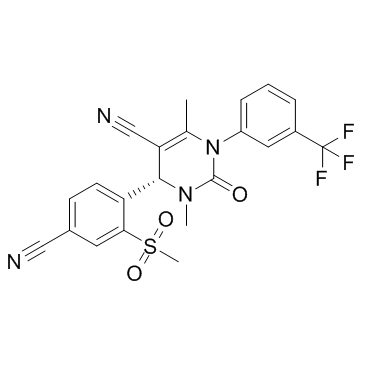| Description |
BAY-85-8501 is a selective and potent inhibitor of Human Neutrophil Elastase (HNE), with an IC50 of 65 pM.
|
| Related Catalog |
|
| Target |
IC50: 65 pM (HNE)[1].
|
| In Vivo |
In this model the exogenous HNE noxa is the primary cause of injury and lung hemorrhage. Based on picomolar potency against HNE as well as single digit potency versus MNE, BAY-85-8501 (29) completely prevents the development of lung injury and subsequent inflammation when administered 1 h prior to the HNE noxa. In the 0.01 mg/kg dose group, hemoglobin concentration is already significantly decreased. At a dose of 0.1 mg/kg, a significant effect on neutrophil count is observed. In this setup, efficacy is predominantly driven by potency against HNE (Ki=0.08 nM). As the highly HNE-selective inhibitor BAY 85-8501 has no effect on PPE, BAY-85-8501 could not prevent the primary lung injury in this setup. Nevertheless, BAY-85-8501 could inhibit MNE, the endogenous driver of inflammation and secondary injury, although with decreased potency. Consequently, the effects of BAY-85-8501 on inflammation and secondary injury are weaker at this point, and only observed at 30-fold higher doses. Efficacy is predominantly driven by potency against MNE (Ki=6 nM) in this second setup[1].
|
| Animal Admin |
Mice[1] Elastaseinduced lung failure in mice, rats or hamsters is a widely used animal model of acute lung failure. The animals are treated 1 hour prior to orotracheal instillation of human neutrophil elastase (HNE) or porcine pancreatic elastase (PPE). In this study, each mouse receives BAY-85-8501 with different concentrations (0.003, 0.01, 0.03, 0.1, 0.3, 3, 10, 30 mg/kg) by P.O.[1].
|
| References |
[1]. Von Nussbaum F, et al. Freezing the Bioactive Conformation to Boost Potency: The Identification of BAY 85-8501, a Selective and Potent Inhibitor of Human Neutrophil Elastase for Pulmonary Diseases. ChemMedChem. 2015 Jul;10(7):1163-73.
|
